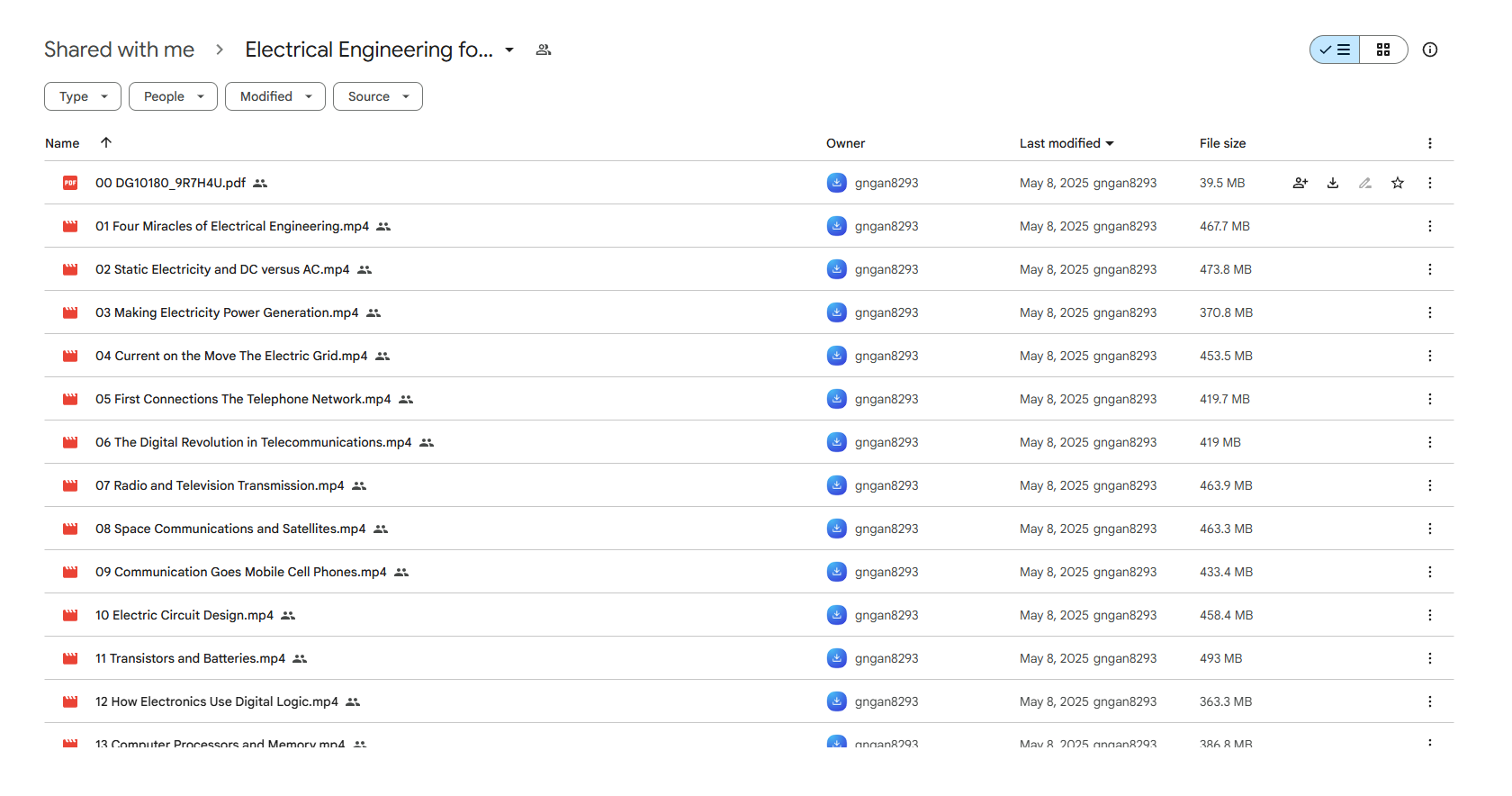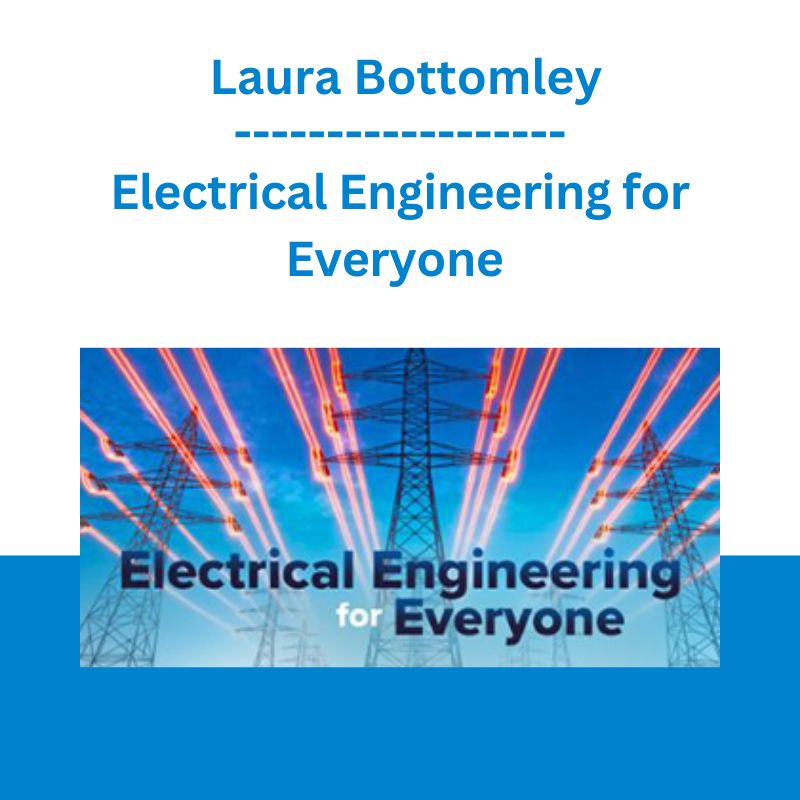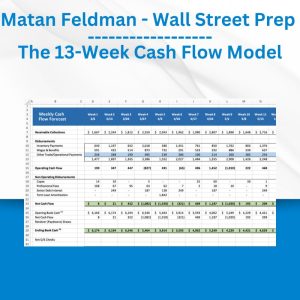*** Proof of Product ***

Exploring the Essential Features of “Electrical Engineering for Everyone – Laura Bottomley”
Electrical Engineering for Everyone
Consider how harnessing the power of the electron has fundamentally changed the world, as you get a thorough introduction to the world of electrical engineering.
LECTURE
Trailer
01:Four Miracles of Electrical Engineering
Discover the four revolutions in electrical engineering that have brought major opportunities and benefits to masses of people in just the past 150 years. Learn, specifically, what each of the four periods brought and the basic properties of the electron and electric circuits on which our entire electrified world is based.
33 min
02:Static Electricity and DC versus AC
From the moment your phone alarm wakes you in the morning until you turn off the lights at night, almost everything you do—cooking, working, driving, checking the news—is possible because of one simple fact: electrons carry energy. Consider the two ways electrons use their energy-carrying ability to create electricity.
33 min
03:Making Electricity: Power Generation
How do we create the massive amounts of energy needed to power our cities and individual homes? We don’t. Energy can neither be created nor destroyed, only converted from one form to another. Learn how electrical engineers use Maxwell’s foundational equations—via four revealing demonstrations—to create generators to power our grids.
26 min
04:Current on the Move: The Electric Grid
No matter what source is used to generate electricity, that power must be distributed and managed to provide continuous and reliable energy for the end user. Explore the US power grid—much of which has been in place for more than 50 years—and discover the significant benefits a “smart grid” would bring.
32 min
05:First Connections: The Telephone Network
In the 1870s, Alexander Graham Bell was trying to improve the telegraph when he and his assistant discovered that speech itself could be transmitted over telegraph wires. Explore the subsequent engineering developments that brought the telephone to almost all households, including Bell’s invention of twisted-pair cabling to reduce crosstalk, still in use today.
29 min
06:The Digital Revolution in Telecommunications
In the old-style analog telephone system, voltage increased and decreased across the wires, corresponding to the human voice signal. But in a digital system, that all changes. Learn how the human voice is changed into binary values, sent over the system, and then converted back into volts with the voltage applied to the speaker in the phone handset. The human ear takes it from there.
30 min
07:Radio and Television Transmission
In the 1880s, Heinrich Hertz proved that the high-frequency phenomena of light and heat are also electromagnetic waves and Nikola Tesla invented the “Tesla coil” which served as the basis for the radio oscillator. Just a few years later, radio signals were being sent and received across the Atlantic Ocean. Examine the additional, fascinating developments that led to the television monitor and then the emergence of digital TV.
32 min
08:Space Communications and Satellites
When the Soviet Union launched Sputnik I in 1957, the space race was on. A US satellite was launched 14 months later and it demonstrated the feasibility of two-way satellite communications. Since then, electronic communications have become part of our daily lives—from weather predictions to digital maps to texting. Follow the fascinating story that has led to the need for us to track almost 10,000 active satellites.
32 min
09:Communication Goes Mobile: Cell Phones
Since 2006, the number of landlines has decreased, while the quantity of mobile phones and other communication devices now outnumber the entire human population. Explore how engineers have created the cellular systems required to manage large numbers of calls at once, even as the user moves from place to place.
31 min
10:Electric Circuit Design
When people first realized that electricity could be controlled, it was the beginning of an explosion of opportunity, eventually leading to electronic circuits—circuits that can control other circuits. Learn why just two laws, Ohm’s law and the conservation of energy, provide all the information and relationships needed to design circuits, as you also explore the properties of semiconductors, diodes, and various color LEDs.
32 min
11:Transistors and Batteries
The development of the transistor was motivated by the need for a device that could amplify signals. How batteries could convert chemical energy to electrical energy was also developed. Learn how the emergence of these two technologies have allowed us to move from electric circuits to electronic circuits, in which one circuit controls another. What does the future hold when we now have transistors as small as atoms?
35 min
12:How Electronics Use Digital Logic
With the advent of logic gates that could be assembled to perform mathematical or logical calculations, engineers could build up from very simple transistors and diodes to a powerful graphic calculator or complex system of facial recognition. Learn about why the numerical basis for logic gates is binary, and how they can be combined to form logic gate circuits.
26 min
13:Computer Processors and Memory
Explore the very earliest electronic computers, including Charles Babbage’s Analytical Engine. Although Babbage was not able to completely build it out before his death, his “engine” was based on the same four components that define computers today—input device, some type of memory to store data and temporary calculations, a calculating processor, and an output device.
28 min
14:Computer Networks: Ethernet to Internet
In the original telephone system, connections were made end to end through switches, and the connection stayed in place until that one conversation was complete. But when email was developed in the 1970s and ‘80s, people weren’t satisfied sending just one type of signal. Explore the development of the ethernet and internet and learn about the protocols that now allow us to send such a wide variety of information types.
32 min
15:Photonics: Fiber Optics to Optical Storage
Discover the many benefits of fiber optics, and the broader field known as photonics, and learn why the field and its applications have exploded since the first lasers were developed in the 1960s. Although we cannot yet transmit power over optical fiber, the technology has brought great advantages in communications security and speed, materials longevity, and cost savings.
32 min
16:Many Kinds of Sensors All around Us
Electronic sensors—instruments that detect some type of physical quantity—have been around for more than 130 years, ever since the invention of the electric thermostat. Explore today’s proliferation of sensors all around us and discover their basic similarities as they convert signals into electrical quantities that can be used to take action.
27 min
17:Electronics Scavenger Hunt
Explore the electronics in a typical home through this lecture’s virtual scavenger hunt. Watch while Dr. Bottomley takes apart a hair dryer, a CD player, a computer CPU, and other machines. You’ll learn about the many electronic components you’ll find inside—resistors, capacitors, inductors, transistors, integrated circuits, electro-mechanical switches, and more.
33 min
18:Electronics of Sound and Music
While sound is not part of the electromagnetic spectrum, it can be manipulated, generated, and shaped by electric circuits. Explore what the signalscope output can tell you about the makeup of various sounds, from a single tone to the human voice to piano chords, and how these can be manipulated by circuits to synthesize entirely new sounds.
31 min
19:Electronics in Medicine and Safety
The entire communication system between our brain and each of our senses is electrochemical, with each of our senses acting as a sensor that emits electrochemical outputs. Learn how this aspect of the body opens the door to electrical engineering solutions for medical problems—from cochlear implants to heart pacemakers to defibrillators. Applying electricity to the human body carries risks, and safety must always come first.
33 min
20:Control Systems: Smart Cars and Smart Grids
Explore cybernetics, systems that use information and feedback to control an output that has some type of goal, with feedback present. Discover the various parts of several cybernetic systems: your car’s cruise control, an implantable insulin delivery pump, and a vending machine—three completely different control systems that all function with the same principles of cybernetics.
32 min
21:Informatics: Signal Processing to AI
When we drive a car, we process signals from all aspects of our environment—visual signals large and miniscule, sound, touch, and even smell. Learn what components we would need to create a reliable and safe system of self-driving cars—with signal processing as the basis—and why the system would be almost impossible to create and maintain without the benefit of artificial intelligence.
34 min
22:Networks of Things: RFID, Bluetooth, and IoT
With the technological development of sensors, feedback control, Bluetooth, and machine learning, we can now network not just computers, but “things” as well. Discover the enormous advantages this “Internet of Things” can provide—from health care to transportation to manufacturing—if we can adequately address the significant concerns regarding privacy and security.
34 min
23:Electrical Engineering in the Everyday World
Dr. Bottomley takes you on a virtual vacation to Rwanda to highlight myriad examples of electrical engineering all around the world. From your garage door opener to airport security, the technologies developed by electrical engineers are all around you before you even board the plane. But it’s the electronics you’ll find in an isolated game park that might really surprise you.
33 min
24:The Evolution of Electrical Technology
What does the future of electrical engineering look like? Explore why answering that question depends on technological advances and … everything else in the physical and cultural environment. Using the now-defunct Picture Phone and Betamax as examples, learn how economics, politics, marketing, culture, and more affect which technologies are brought to market, and which will succeed.
37 min
DETAILS
Overview
To many of us, electricity can still seem like the “magic” our ancestors imagined it to be when they saw it in the natural world. But the science of electricity is considerably more amazing than magic, as you’ll see in the 24 fascinating lectures of Electrical Engineering for Everyone. With dozens of live demonstrations, along with explanatory graphics and video, Dr. Laura J. Bottomley brings you on the amazing journey of electrical engineering—the discipline that has taken us from the electric lightbulb to interstellar space to artificial intelligence in less than 150 years.
About
Laura J. Bottomley
Electricity is almost like magic. Poof, lights on. But unlike magic, once you understand how it works, electricity is even more fascinating when you encounter it in your daily life.
Laura J. Bottomley is the director of Women in Engineering, Engineering Education, and The Engineering Place at NC State University, where she earned her PhD in Electrical Engineering. She has worked at Texas Instruments and Bell Laboratories and has received the Presidential Award for Excellence in Mathematics, Science and Engineering Mentoring. She was named a fellow of the Institute of Electrical and Electronics Engineers and was elected to the YWCA Academy of Women. She is the author of Creating a Better World: Innovation, Ingenuity, and Engineering.
REVIEWS
MichiganLifeLongLearner
Tecumseh, MI
Wow! Much More Than I Expected
Things started out a bit slow but picked up quickly, covering way more than I expected. She effectively used a large number of demonstrations to convey the material and concepts and shared great examples from her career. Also, she was very easy to understand and follow.
Mrburp
Covers lots of electrical things not only engineer
very easy to understand. non technical showing for technical we take for granted
ZZZZ1
The title EE for everyone is appropriate..
The discussions were good, even people without a science degree will benefit from these lectures. The examples and demonstrations left a lot to be desired. The instructor needs to pay more attention as to what camera is active.
Please see the full list of alternative group-buy courses available here: https://lunacourse.com/shop/










 Erik Banks - Alternative Risk Transfer
Erik Banks - Alternative Risk Transfer  Ed Ponsi - Forex Trading
Ed Ponsi - Forex Trading  Atlas API Training - API 570 Exam Prep Training Course
Atlas API Training - API 570 Exam Prep Training Course  Racing Workshop - Complete Online Package
Racing Workshop - Complete Online Package  Trade Like Mike - The TLM Playbook 2022
Trade Like Mike - The TLM Playbook 2022  Dave Landry - Stock Selection Course
Dave Landry - Stock Selection Course  Simpler Trading - Bruce Marshall - The Options Defense Course
Simpler Trading - Bruce Marshall - The Options Defense Course  Sovereign Man Confidential - Renunciation Video
Sovereign Man Confidential - Renunciation Video  George Fontanills & Tom Gentile - Optionetics 6 DVD Series Home Study Course (Digital Download)
George Fontanills & Tom Gentile - Optionetics 6 DVD Series Home Study Course (Digital Download)  Oliver Velez - Essential Strategy Of Trade For Life
Oliver Velez - Essential Strategy Of Trade For Life  Money Miracle - George Angell - Use Other Peoples Money To Make You Rich
Money Miracle - George Angell - Use Other Peoples Money To Make You Rich  Team NFT Money - Ultimate NFT Playbook
Team NFT Money - Ultimate NFT Playbook  Emanuele Bonanni - My Trading Way
Emanuele Bonanni - My Trading Way  Chris Capre - Advanced Price Action Ongoing Training & Webinars
Chris Capre - Advanced Price Action Ongoing Training & Webinars  The Daily Traders – Exclusive Trading Mentorship Group
The Daily Traders – Exclusive Trading Mentorship Group  Matan Feldman - The 13-Week Cash Flow Modeling - Wall Street Prep
Matan Feldman - The 13-Week Cash Flow Modeling - Wall Street Prep  Crypto Dan - The Crypto Investing Blueprint To Financial Freedom By 2025
Crypto Dan - The Crypto Investing Blueprint To Financial Freedom By 2025  SMB - Options Training
SMB - Options Training